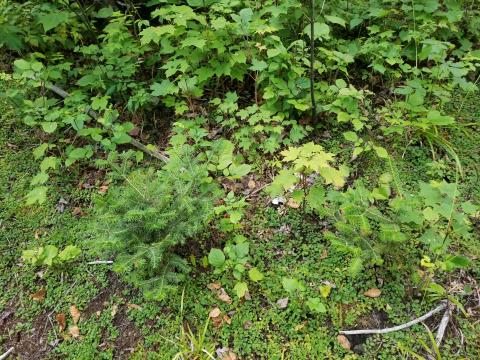
As a forester, a common question I get is “do you plant trees after logging?” While this is common practice in other parts of the country and the world, here in New England tree planting as a part of forestry is unusual. Instead of planting, we typically rely on natural regeneration of trees. There are several reasons for this.
Why Utilize Natural Regeneration
Due to adequate year-round rainfall and reasonably fertile soils, trees readily regenerate on their own in our region. Consider that one time much of New England was cleared of its forests and converted to agriculture, then forests readily grew back on their own after farm abandonment, with limited planting by people.
Because trees regenerate well on their own, planted trees have lots of competition. Controlling this competition is costly and time consuming. (I managed a property where a stand had been cleared of hardwoods and planted with spruce twenty years prior. It was hard to tell it had been planted due to the dense growth of sugar maple and yellow birch. The spruces, which represented a substantial investment of money, time, and labor, were shaded out by the hardwood growth.) In our region, most species that regenerate naturally have commercial value. Therefore, planting to ensure a steady supply of favorable species is not as necessary as in other areas of the world where only a few species have marketable value.
Growth rates are another factor, as it takes a long time to grow a tree to sawlog size in New England. Usually, the cost of waiting for trees to grow outweighs the investment to plant the trees. In other regions with shorter time spans from seedling to harvestable tree, it makes economic sense to plant.
While most of our tree species have commercial value, some species are worth more than others in the market. Similarly, some species benefit wildlife more than others, or are more adapted to a changing climate. The task for foresters is to create conditions for the natural regeneration of desired species, whatever the goal might be. This is where silviculture comes in.
Silviculture
Silviculture, according to silviculturist David M. Smith, author of a widely used text on the subject, can be defined as “the theory and practice of controlling forest establishment, composition, structure, and growth”. Foundational to silviculture is silvics, “which deals with the principles underlying the growth and development of single trees and of the forest as a biological unit” (Smith).
Sunlight and Shade
One of the most important concepts in silvics is shade tolerance. Tree species are on a spectrum of shade tolerance, from very shade tolerant to very shade intolerant, and different gradients in between. A tree species’ shade tolerance characteristics are critical when considering how to get new seedlings established.
Very shade tolerant species include hemlock, red spruce, and beech. These species can germinate and persist in the deep shade of a closed canopy forest. They don’t necessarily thrive in these conditions, but they will persist, which gives them a competitive advantage over less shade tolerant species. A sapling size hemlock may be mistaken for a young tree, but in reality, it may be 40 or 50 years old or more.
On the shade intolerant end of the spectrum, we find species such as paper birch and aspen. These species won’t regenerate in shade. They need full sun and warm soil to germinate and thrive. Known as pioneer species, their competitive advantage is that they are among the first trees to establish after a heavy disturbance such as fire or clearcutting.
Between these two extremes lie numerous species. Red oak, white ash, yellow birch, and white pine all exhibit intermediate shade tolerance. They tend toward one end or another of the spectrum - for example, yellow birch is less tolerant while white ash is more tolerant of shade.
Site Plays a Role
Site is also a factor in silviculture. Soil fertility and structure, drainage, slope, aspect, and elevation all play a role in in which species of trees can be regenerated on a site.
Site characteristics need to be taken into consideration in forestry planning, but there is little, if anything, the forester can do to influence them. The forester can, however, manipulate the light levels that reach the forest floor. This is done through different silvicultural treatments, which involve cutting trees and often include selling the harvested wood.
Based on stewardship goals, site characteristics, and shade tolerance of the desired species, foresters develop various silvicultural treatments. They range from clearcutting to regenerate shade intolerant species to single tree selection to regenerate very shade tolerant species, and many variations in between.
Planting Can Play a Role
Efforts at natural regeneration aren’t always successful. Excessive deer and moose browsing can keep natural regeneration from developing, and invasive plants can prevent successful establishment of native tree species. Poor logging practices that haven’t taken the future forest into consideration can hinder regeneration of desired species. (For example, the stand may have had spruce and fir seedlings that became established in the shade, but skid trails weren’t planned to avoid damage to the seedlings, resulting in their loss.) Along with this, misunderstanding the silvics of the target species can result in regeneration failure. (Clearcutting in spruce-fir when no seedlings were established prior to harvest will result in shade intolerant hardwoods occupying the site, rather than the desired spruce and fir.)
In these situations, enrichment planting is an option to enhance the regeneration. The goal is to enrich the species composition, improve timber value, or increase stocking. The focus isn’t on establishing plantations of trees, but rather to fill in places where regeneration may have failed or where species composition lacks diversity. (I worked on a planting project in Maine where the understory prior to harvesting was almost entirely beech. The goal was to improve the species composition and future value by planting spruce and pine with the existing hardwoods.)
Planting can also enhance wildlife food sources. Native dogwoods, elderberry, and winterberry, or introduced, but non-invasive, species such as apple all benefit wildlife. Like all plantings, these shrubs and trees need to be protected from competition and wildlife damage while they become established. Before deciding to plant, examination of the site is important. See if fruit and nut-bearing plants are already there and can be helped along by cutting trees that are shading them out.
Most of us like the idea of planting trees. In a forested setting, however, planting is often not needed at all. Planting can play a role, however, when regeneration is unsuccessful, or species diversity needs to be enhanced.
Learn More
If you want to learn more about stewardship of your forest, you can contact your county forester to set up a site visit. If you’re looking to plant trees or shrubs, the NH State Forest Nursery is a good source of seedlings. Sales have been brisk, so be sure to contact them about what they have in stock. https://www.nh.gov/nhnursery/
Consider attending the Grafton County Conservation District Planting and Pruning workshop at Windy Ridge Orchard in North Haverhill on April 29, 2022, from 5:30pm to 7 pm. There will be demonstrations on blueberry pruning, apple pruning, tree planting techniques and site selection. Contact Pam Gilbert for details on the workshop, 603-353-4652, pamela.gilbert@nh.nacdnet.net.
Have a question about your woods? Contact your Extension County Forester today!
Do you love learning about stuff like this? Subscribe to the NH Woods & Wildlife Newsletter.
A quarterly newsletter providing private woodlot owners in New Hampshire with woodlot management news, pest updates, resources, and more.

